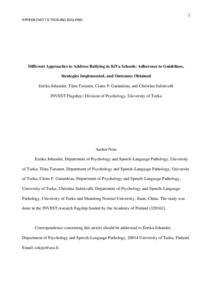Different Approaches to Address Bullying in KiVa Schools: Adherence to Guidelines, Strategies Implemented, and Outcomes Obtained
Johander Eerika; Turunen Tiina; Garandeau Claire; Salmivalli Christina
https://urn.fi/URN:NBN:fi-fe2021042822782
Tiivistelmä
We
examined the extent to which school personnel implementing the KiVa®
antibullying program in Finland during 2009–2015 systematically employed
the program-recommended approaches (confronting or non-confronting), used one or the other depending on the bullying case (case-specific approach), or used their own adaptation
when talking to perpetrators of bullying, and whether they organized
follow-up meetings after such discussions. In addition to investigating
adherence to program guidelines, we tested how effective these different
approaches were in stopping bullying. Finally, we tested the
contribution of follow-up meetings and the number of years KiVa had been
implemented in a school to the effectiveness of the interventions,
using reports from both school personnel and victimized students. The
data were collected annually across 6 years via online questionnaires
and included responses from 1221 primary and secondary schools. The
school personnel were more likely to use the confronting approach than
the non-confronting approach. Over time, rather than sticking to the two
program-recommended approaches, they made adaptations (e.g., combining
the two; using their own approach). Two-level regression analyses
indicated that the discussions were equally effective, according to both
personnel and victimized students, when the confronting, non-confronting, or a case-specific approach had been used. The discussions were less effective when the personnel used their own adaptation or could not specify
the method used. Perceived effectiveness was higher in primary school
and when follow-up meetings were organized systematically after each
intervention, but unrelated to the number of years KiVa had been
implemented.
Over the past decades, growing awareness of the negative outcomes of school bullying (Reijntjes et al. 2010)
has in many countries led to normative regulation, such as schools
being required to have a policy, or an action plan against bullying
(Salmivalli 2018). School personnel are thus faced with a demand to do something
to address bullying. At the same time, numerous antibullying programs
have been developed and evaluated in different parts of the world
(Gaffney et al. 2019).
Such programs often combine preventive actions (such as student lessons
or improved supervision) with targeted interventions (i.e., procedures
for intervening in actual bullying cases, such as discussions with the
students involved). Evaluation studies have, however, mainly estimated
the effects of whole programs (without distinguishing prevention from
intervention components), and the few studies that have compared the
effectiveness of different approaches in targeted interventions only
assessed short-term effectiveness on the basis of a single student
informant (Garandeau et al. 2014, 2016).
Consequently, we know little about the relative effectiveness of
different approaches used when a case of bullying has already occurred,
and even less about how school personnel implement guidelines provided
to address such cases. The present study investigates the extent to
which school personnel implementing the KiVa® antibullying program
(Kärnä et al. 2011a)
in Finland employ the program-recommended approaches (confronting vs.
non-confronting) when discussing with bullying perpetrators, how this
changes over a period of 6 years, and how effective the chosen
approaches (whether program-recommended or something else) are perceived
to be by the school personnel and by the students who have been
victimized.
Kokoelmat
- Rinnakkaistallenteet [27094]
